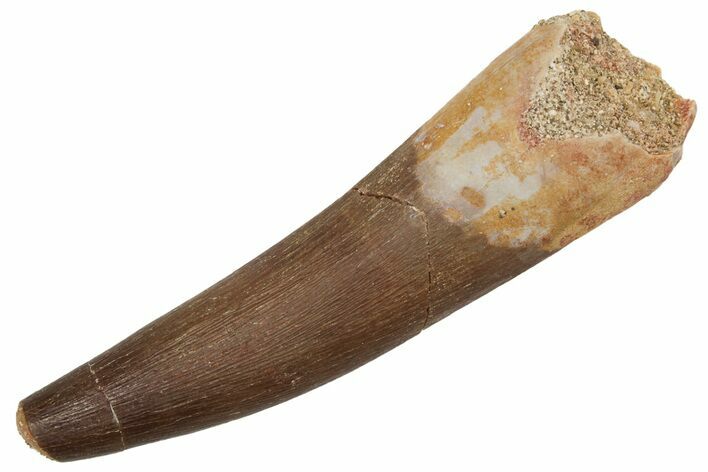This Specimen has been sold.
2.34" Fossil Plesiosaur (Zarafasaura) Tooth - Feeding Worn Tip
This is a 2.34" long tooth from a large, dinosaur-aged plesiosaur (Zarafasaura oceanis). It was collected from the phosphate deposits in the Oulad Abdoun Basin of Morocco.
There is a repaired crack through this tooth.
There is a repaired crack through this tooth.
About The Plesiosaur Zarafasaura
Zarafasaura is a genus of plesiosaur that lived during the Late Cretaceous period, around 70 million years ago. Known primarily from fossils found in the phosphates of the Ouled Abdoun Basin in Morocco, Zarafasaura is notable for being one of the last plesiosaurs to exist before the mass extinction that ended the age of dinosaurs.
This marine reptile belonged to the family Elasmosauridae, known for their long necks and small heads, adapted to snatch prey in the open ocean. Zarafasaura had a moderately long neck, although not as extreme as some other elasmosaurs, and a streamlined body with powerful flippers that allowed it to move gracefully through the water. It likely fed on fish and squid, using quick, precise strikes to catch its prey.
Zarafasaura's skull is distinctive, with robust jaws and sharp, conical teeth that indicate it was a predator capable of grasping slippery prey. Its fossils provide important insights into the diversity of marine reptiles in the North African region during the Cretaceous and highlight the adaptations of elasmosaurs to a range of marine environments.
This species of of Plesiosaur was redescribed from Plesiosaurus mauritanicus to Zarafasaura oceanis in a 2011 paper which can be found at:
A NEW SPECIMEN OF THE ELASMOSAURID PLESIOSAUR ZARAFASAURA OCEANIS FROM THE UPPER CRETACEOUS (MAASTRICHTIAN)OF MOROCCO
Zarafasaura is a genus of plesiosaur that lived during the Late Cretaceous period, around 70 million years ago. Known primarily from fossils found in the phosphates of the Ouled Abdoun Basin in Morocco, Zarafasaura is notable for being one of the last plesiosaurs to exist before the mass extinction that ended the age of dinosaurs.
This marine reptile belonged to the family Elasmosauridae, known for their long necks and small heads, adapted to snatch prey in the open ocean. Zarafasaura had a moderately long neck, although not as extreme as some other elasmosaurs, and a streamlined body with powerful flippers that allowed it to move gracefully through the water. It likely fed on fish and squid, using quick, precise strikes to catch its prey.
Zarafasaura's skull is distinctive, with robust jaws and sharp, conical teeth that indicate it was a predator capable of grasping slippery prey. Its fossils provide important insights into the diversity of marine reptiles in the North African region during the Cretaceous and highlight the adaptations of elasmosaurs to a range of marine environments.
This species of of Plesiosaur was redescribed from Plesiosaurus mauritanicus to Zarafasaura oceanis in a 2011 paper which can be found at:
A NEW SPECIMEN OF THE ELASMOSAURID PLESIOSAUR ZARAFASAURA OCEANIS FROM THE UPPER CRETACEOUS (MAASTRICHTIAN)OF MOROCCO
It comes from the massive phosphate deposits in the Oulad Abdoun Basin near Khouribga, Morocco. These deposits are mined for phosphate, one of Morocco's biggest exports. The fossils are collected as a byproduct of the mining operations, saving them from certain destruction by the rock crusher.
SPECIES
Zarafasaura oceanis
AGE
LOCATION
Oulad Abdoun Basin, Morocco
FORMATION
Phosphate Deposits
SIZE
2.34" long
CATEGORY
SUB CATEGORY
ITEM
#231097
We guarantee the authenticity of all of our specimens.
 Reviews
Reviews













